[/caption]
New high-resolution images taken last month of Mars’ south polar region are revealing signs of spring that are decidedly Martian.
The image above features a spider trough network left behind as seasonal dry ice caps have sublimated away in the warmer temperatures. It’s part of a new series of images released this week by the University of Arizona’s High Resolution Imaging Experiment, or HiRISE, aboard NASA’s Mars Reconnaissance Orbiter.
See more information and photos below.
The gas beneath the ice cap can flow in the same places year after year, eroding troughs in the surface of the planet.
“What happens on Mars, we think, is that as the seasonal ice cap thins from the bottom, gas underneath the cap builds up pressure,” said HiRISE deputy principal investigator Candice J. Hansen-Koharcheck of the NASA Jet Propulsion Laboratory in Pasadena, California.
“And where gas under the ice finds a weak spot or a crack, it will flow out of the opening, often carrying a little dust from the surface below.”
The next HiRISE image shows how dust that has been carried to the surface by gas jetting through the ice cap is blown about by prevailing winds before settling in fan-shaped deposits atop the ice cap. Varying orientations suggest that as the ice layer thins, a set of gas jets becomes active, they die down, then further away another set starts up at a later time with a different prevailing wind direction.
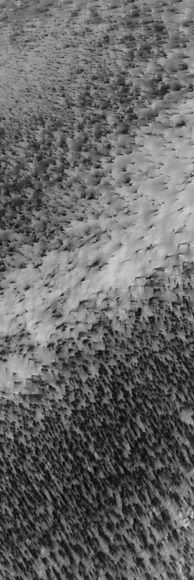
Many jets appear to be active at the same time since numerous fans are all deposited in the same direction: this next, closer image is an example of such an occurrence.
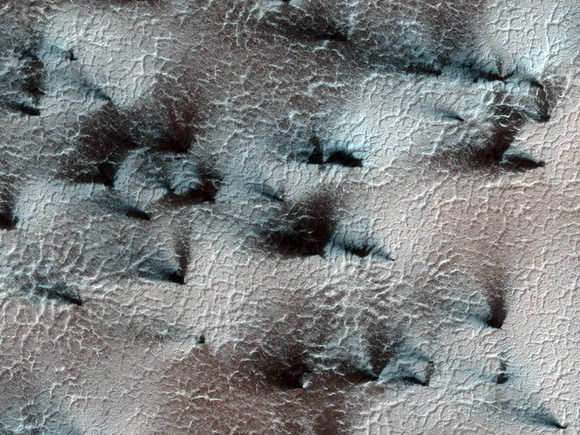
This southern hemisphere crater has gullies on its north and northeast walls. Gullies are proposed to be carved by liquid water originating from the subsurface or melting ice/snow on the surface.
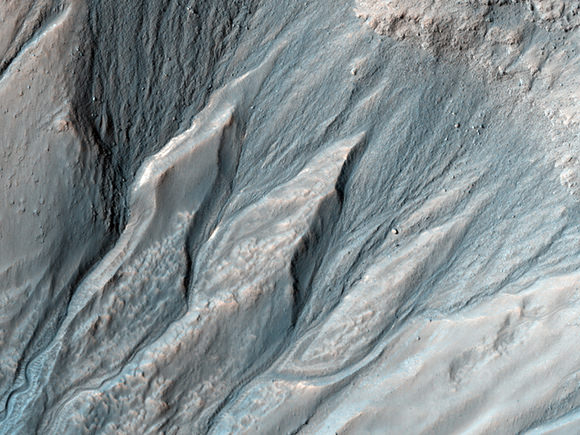
Dark dunes are visible on the crater floor. Lighter, smaller dunes rim the south side of the crater floor. The entire scene, pictured below, has a pitted texture, suggesting that ground ice was once present in this region. When ground ice sublimates (goes from a solid directly to a gas), it leaves behind empty spaces in the soil that turn into pits as the remaining overlying soil collapses to fill them.
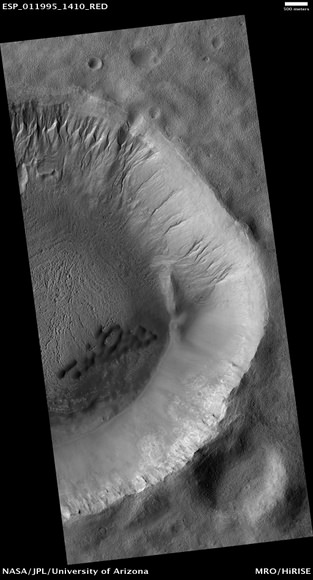
The full set of new HiRISE Mars images is here. Check out all the downloadable formats and sizes, with some even designed to fit an iPhone screen!
Source: Lori Stiles, at the University of Arizona

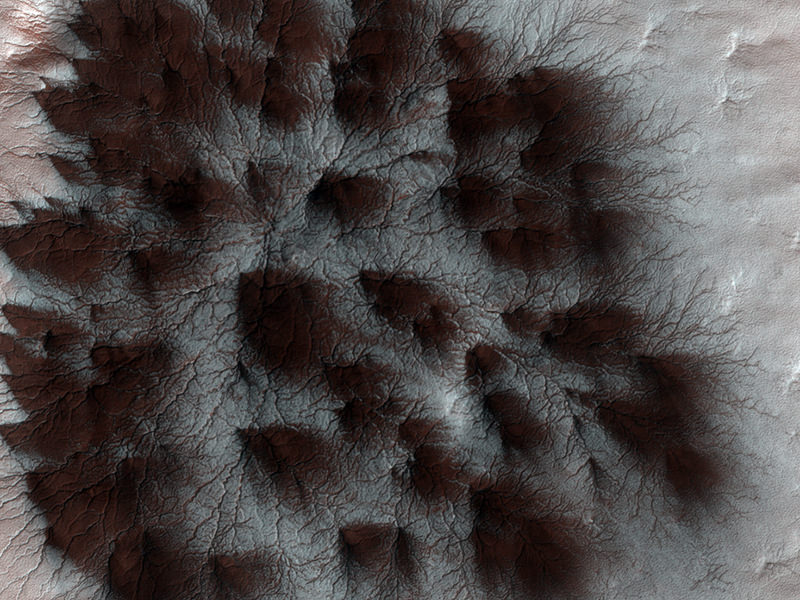
Looks like bathroom mold.
phoenix out of the ice yet? any chance it might have survived intact, or is it doubtlessly crushed into tiny pieces too small to photograph
The top photo looks like there is a drainage system back into the middle of these vents. I wouldn’t think there would be much of anything liquid there. Just seems strange.
Pheonix is not out of the ice for some time yet. Can’t remember exactly how long the Martian winter lasts (someone else posting here will know for sure!), but…
…it is very unlikely Pheonix will survive. The temperatures & dry ice are expected to crack the solar panels, and most likely the electronics will also not survive.
Pheonix is basically dead… Maybe we’ll get a nice surprise at the end of the Martian winter, but we probably won’t.
tom wonders:
“phoenix out of the ice yet?”
like tek_604 said…. and also: Phoenix is sitting in the North polar region – these images are of the area around the South pole. Like on Earth, when the South pole starts freezing over again, after the Southern summer, the North will start thawing out. Note that the Martian year is almost twice as long as ours.
It’s sad that in 2009 we still can’t get true color pictures of fascinating Mars phenomena like this. The great astronomer Earl Slipher and others observed color change surrounding the receding Mars polar cap in the decades before space probes, which helped gain him nothing but ridicule. Is this what they saw? Do these help explain the “wave of darkening” that he and others reported? Are these dynamic features habitats for life? Are they signs of life? Erupting CO2 from sublimation is just a theory – but the fact that no one seems to be interested on finding life on Mars – what gives?
I have never heard an adequate explanation of exactly how carbon dioxide sublimation produces spider-shaped gopher burrow looking formations. If much of the experts’ thinking on Mars is based on Earthly analogies, what on Earth is the analog here? If nothing, then exactly what mechanism is proposed to account for carbon dioxide gas radiating underground in burrows from a central source in a highly organized and reproducible pattern? I have heard admonishments on this forum for daring to question the experts, yet the best theory of this phenomenon put forth by the scientists associated with the misson looks to be poorly founded and lacking in detail. Perhaps there is a technical paper with a decent explanation that has not connected with the popular press?
@TD:
We already explained this to you on the Dawn MGA post on the 12th March. Imaging from these probes/satellites is done through many filters, each sensitive to a different portion of the spectrum. These can then be put together to form the colour images you see…
Basically, you can get sod all science from imaging with a digital camera as you see it. Yes, the cameras flown today are basically the same (in that they use CCD), but are scientific instruments, with complex filter systems, each flown for a reason, to detect something scientists believe is/is not there.
Thanks tek – I was interested enough after the previous blog response to email the HiRise team directly. The wavelength combinations available cannot be reconstructed into an R G B image we might see in person.
In fact, a document available says it directly:
http://hirise.lpl.arizona.edu/pdf/color-products.pdf
under “What do the colors in HiRISE images mean?”
” It isn’t natural color, as seen by normal human eyes, because the IR, RED, and BG channels are displayed in red, green, and blue colors.”
There’s always a chance I’m mistaken. If you can explain how to get colors which a human would see on Mars out of the HiRise images, great….School age children will be fascinated. If not, a generation of school chidren will think Mars is a disco-colored alien world…and never be aware that the temperature right at the surface can reach 80F at times. Unbelievable that we could let the next generation of minds – some of them briliant – slip away from science because we couldn’t inspire them with the great things we know about Mars. Very sad.
I really hope they keep an eye on these regions.
Mein gott, this looks like it was designed by H.R. Giger himself. Do NOT go looking for a stray cat here alone! Then, if you had a cat that could survive this harsh place….okay enough of my nonsense.
What amazing photos!
The first image looks like a future “Where in the Universe” photo. I’m committing this one to memory: Mars south polar region, MRO HIRISE. – Got it!
I was told by Bill Nelson, Team Manager for the rover team, that the Phoenix is not expected to survive the polar winter. The ice load will be just too much on its instruments. But it has achieved its objectives, so is considered a successful mission. Maybe it will live up to its namesake and rise again from the ice in the spring, but it’s not likely or expected.
Love these HiRISE images though! The detail is amazing, and the natural processes they show are just fascinating.